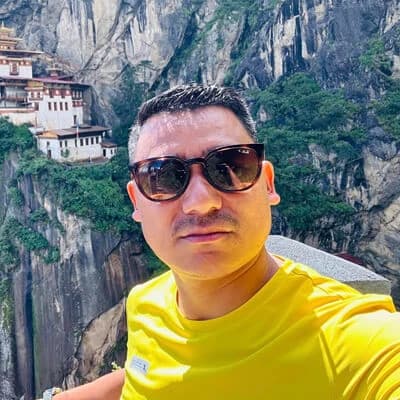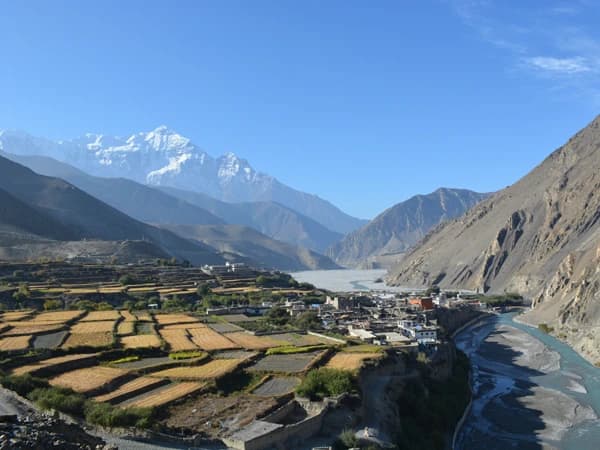Things to do in around Kathmandu
Here are some of the things that you should try in Kathmandu:
- Discover a world of flavor in Nepal, from wholesome dal-bhat to popular momos and more
- Fly past the Himalayas, and go eye-to-eye with Mt. Everest, and the world’s highest peaks within minutes
- Take a course in woodcarving, stone masonry, pottery or learn delicate Thangka painting
- Rejuvenate your mind, body, and soul through yoga that delves deeply into you
- Discover inner peace and positive energy through the ancient practice of meditation
- If you are looking for holistic physical healing through non-invasive methods, Ayurveda could be of interest to you
Monuments (Bhaktapur Durbar Square, Kathmandu Durbar Square, Patan Durbar Square, Pashupatinath Temple, Boudhanath Temple, Swayambhunath Temple)
No big surprise the entire of Kathmandu Valley was assigned a World Heritage Site in 1979 because of its seven exceptional historical landmarks.
Bhaktapur Durbar Square
Is the center point of Bhaktapur Durbar Square is 55-Window Palace, which is a blend of pagoda-and shikhara-style sanctuaries. The Square likewise has enormous stone monuments on which are statues of old rulers. You'll additionally be inspired by the Lion Gate (1696), which has two unnerving stone pictures of Shiva and Ugrachandi. The Golden Gate, which is luxuriously made and is surmounted by pictures of Goddess Kali and Garuda, the legendary man-winged creature. This entryway leads into the primary yard of the 55-Window Palace that was worked amid King Yaksha Malla reign in 1427.
Kathmandu Durbar Square
Kathmandu Durbar Square is also known as Hanuman Dhoka, which has been royal residences of the Malla and Shah Kings in past days. The royal residences were worked around the Tenth Century. The Malla rulers ruled over Kathmandu from these royal residences from King Ratna Malla's time (1484-1520). In the watch of King Prithvi Narayan Shah's triumph of the valley in 1769, Hanuman Dhoka turned into the seat of an intensity of the Shah Dynasty who ruled from the Square till 1896 preceding proceeding onward to Narayanhiti Palace.
Patan Durbar Square
Patan Durbar Square is located in the focal point of Patan town, also called Lalitpur (the City of the Arts). The Imperial group of Patan ruled over this piece of the Kathmandu valley from this Square. There are three noteworthy yards in the castle: Mul Chowk, Sundari Chowk, and Keshav Narayan Chowk. Sundari Chowk is recognized by the nearness of Tusha Hiti, an indented watering spot, the creativity of which makes it something other than some other watering spot. Mul Chowk is the oldest of the three while Keshav Narayan Chowk is the place Lalitpur's soonest Malla castle was fabricated.
Pashupatinath Temple
On the banks of the Bagmati River one of the holiest sites of Hindus is located, Pashupatinath Temple. Many religious ceremonies, for example, Maha Shivaratri, Teej Akshaya, Sankranti, Rakshabandhan are celebrated here hugely every year. The pagoda style sanctuary is luxuriously ornamented and it houses the sacrosanct Lingum (phallic image of Shiva), which has four faces and goes back to the Fourteenth Century.
Confronting the front of the sanctuary is a 300-year-old bronze figure of Nandi, Shiva's carrier, the bull. Behind the sanctuary is the Aryaghat, the incineration ground where all Hindus of Nepal try to be incinerated when their time comes. The complex has numerous different sanctuaries committed to different divine beings.
Boudhanath Stupa
Boudhanath Stupa lies around 7 km east of the downtown area, and it is said to be the biggest stupa on the planet. It stands 40 m high and has a distance across of somewhere in the range of 100 meters. Otherwise called Kahasti Chaitya, Boudhanath is the holiest Buddhist site in the nation. A pyramid remains at the highest point of the vault on which are painted according to Buddha in red, white, and blue. The expansive arch is based on a three-layered base around which is a circumambulatory way with lines of petition wheels just as 108 Buddhist gods.
Cloisters of each of the four schools of Mahayana Buddhism are to be found inside the stupa premises. Celebrations like Lhosar are praised with much energy here. As per specialists, King Manadeva was the one to construct the Stupa amid the Licchavi time frame after which it experienced a few redesigns in the Seventeenth Century.
Swayambhunath
Swayambhunath is one of the holiest places of worship in Kathmandu Valley and is situated on a cone-shaped lush peak. It has a grand white arch and sparkling brilliant tower alongside the all-powerful eyes of Buddha (alongside a third eye). If you climb the stairs, you'll pass a plated vajra and encounter two stone lions guarding the door at the best.
The Swayambhunath complex has numerous chaityas, sanctuaries, and painted god pictures dispersed around the site. You'll get to see many monkeys here, as in Pashupatinath, yet maybe in bigger numbers. As of late, numerous new augmentations have come up around the site, including a 57-foot statue of Buddha. Buddha Jayanti, Gunla, and Lhosar are events when thousands of crowd to the hallowed place.
Things to do in Pokhara
Ashmita Trek & Tours presents you the best things to do in Pokhara, which are Pokhara is known for.
So here are some of our top things-to-do in Pokhara:
- Explore old Pokhara on a bike
- Boating in the tranquil Phewa Lake
- Enjoy the views from the Peace Stupa
- Come very close with bats at the Bat Cave
- Feel the adrenaline surge of wilderness boating
- Enjoy the dusk at Sarangkot Viewpoint
- Escape from the group and chill at Begnas Lake
Landmarks (Davi’s Falls, Mahendra Cave, Seti Gorge, World Peace Pagoda, Bat Cave, Fewa Lake, Lakeside)
These are the most mainstream landmarks of Pokhara. Truly, Pokhara is the city of Lakes, and definitive heaven of the Himalayas and has dependably been at the front position as far as the travel industry in Nepal.
In this way, here is a portion of the tourist spots in Pokhara, which are quickly depicted beneath:
Davi’s Falls
Devi's Fall, the otherworldly sight of nature at the lower end of Fewa dam is additionally prominent for its legend. The fall is named after the name of a doomed traveler who was cleared away by a sudden stream of Fewa Lake. The loosening up visitor did not know the sudden out stream of the water and cleared route into the passage or pines for and vanished. From that point forward the fall has named as Devi's fall and has turned into a prevalent site for the guests.
Mahendra Cave (Bat Cave)
Mahendra Cave, found in 1950, is a standout amongst the most well-known visiting spot in Pokhara Nepal. 95% voyagers go to visit the buckle. It is in around 10 minutes drive from the core of Pokhara city in the place named Batulechaur. As one of the darker destinations in Nepal, the cave offers guests the chance to set out on a thrilling exploration. The inside of the cave is a superb formulation of common limestone.
Seti Gorge
Seti River has made great crevasses in numerous parts of Pokhara. In some area, the canyons go in excess of 200 meters down through the width is just around 20 meters. The best places to watch the wild component of Seti River are K. I Sing Bridge, Mahendra Pool Bridge, Prithvi Chowk Bridge, and some other little intersections of the valley.
World Peace Pagoda
World Peace Pagoda, on the southwest bank of Fewa Lake and on the highest point of Raniban, is the best site for a day climb. One hour delicate trek is likewise the best chance to encounter nearby culture and convention. Stupa site is a most supported site for inward and outside sightseers in Pokhara. You will also get to see stunning views mount Machhapuchhre from the top.
Fewa Lake
Fewa Lake is an unmistakable milestone of Pokhara. It lies on the west corner of Pokhara valley. The lake covers a territory of 4.4 sq km. The west bank of the lake is encompassed by green moving slope and thick timberland and on the east of the lake, there are hundredth of inns, lodges, eateries, travel and trekking workplaces, shops and other traveler related administration focuses.
In addition, drifting on Fewa Lake will be an exciting minute once you look the once in a while the delightful shadow of Machhapuchhre underneath of your vessel. You can even cover this well-known milestone of Pokhara in the event that you happen to stroll for Annapurna Circle Trek.
Lakeside
Lakeside is a well-known traveler site alongside to Phewa Tal (lake) in Nepal's second biggest city Pokhara. Inside Lakeside there's currently a north Lakeside and a South Lakeside. It's very simple to explore as visitor transports drop most travelers off at the outskirt among Lakeside and Damside. After that, it's a simple walk to the beginning of south Lakeside and into the continuous improvement of North Lakeside. For the vast majority, it's simply "Lakeside" - which comprises of a tranquil primary street that keeps running close by Lake Phewa Tal in Pokhara.






